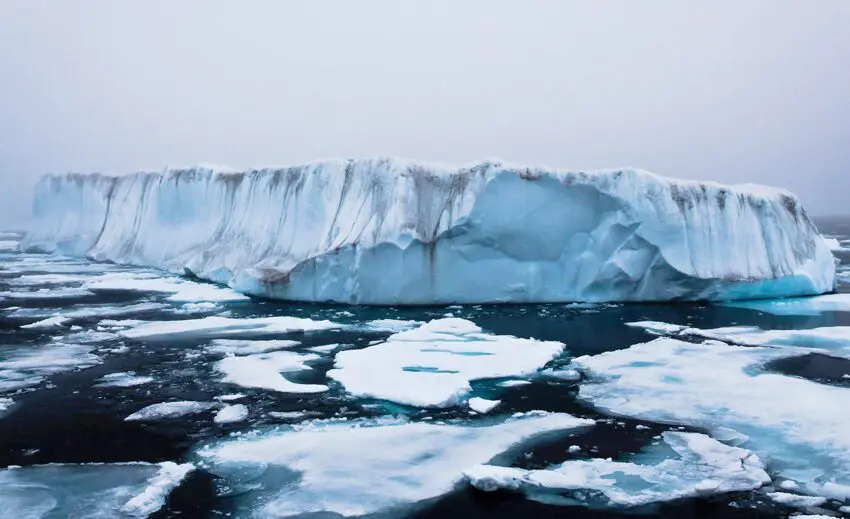Icebergs in broken sea ice

An iceberg in broken sea ice to the north-east of Greenland captured during Oden Arctic Technology Research Cruise in 2013. Photo: Anna Pustogvar.
Top image: An iceberg in broken sea ice to the north-east of Greenland captured during Oden Arctic Technology Research Cruise in 2013. Photo: Anna Pustogvar.
Drifting icebergs can be a serious threat to Arctic and subarctic offshore activities. PhD candidate Renat Yulmetov analysed the drift of icebergs in broken sea ice and investigated the possibility of iceberg towing in sea ice to protect offshore structures. Yulmetov will defend his PhD thesis on 12 January 2017 at UNIS.
6 January 2017
Press release from the University Centre in Svalbard (UNIS) and Norwegian University of Science and Technology (NTNU)
Icebergs are massive pieces of ice, floating or grounded, which have broken away from glaciers. A one-million-ton iceberg can be considered as ‘medium-sized’. Potential collision with such a heavy object may cause significant damage to a ship or an offshore structure, threatening human lives and the environment.
Collisions with an offshore structure may be avoided by implementing ice management techniques. First of all, icebergs have to be detected as early as possible. Secondly, their drift has to be accurately forecasted. If a collision is likely to occur, an iceberg may be deflected by towing it away using an offshore supply vessel. Finally, if towing fails, then the offshore structure should be possible to disconnect and remove from the site, which is very costly and risky. These techniques have been well established for iceberg drifting in open water, but are it possible to do the same for an iceberg surrounded by broken sea ice?
Towing of icebergs in broken sea ice
Renat Yulmetov studied the drift of nine icebergs and 18 ice floes to the north-east of Greenland and to the south-east of Svalbard using GPS trackers. The drift tracks were analysed to find drift velocities, trajectory curvatures, velocity spectra and to estimate relative drift of ice and icebergs. In addition, the yawing of icebergs has been measured for the first time. All of this information is highly relevant to iceberg management and basically tells us what to expect from a drifting iceberg.

The rotation of drifting icebergs to the north-east of Greenland was surprisingly consistent, making between one and two full revolutions per 24 hours. Tidal currents were found to be responsible for the rotation and the process was successfully modelled numerically using a new drift model involving rotation.
In addition, a numerical model of iceberg towing in broken ice has been developed. In the model, the behaviour of the iceberg and every ice floe is described by their own equations of motion. They interact with each other and the interaction forces at every contact between them are estimated in a special way. The model can efficiently simulate an iceberg moving through an ice field containing thousands of ice floes. An algorithm has been developed, that efficiently generates such ice fields containing ice floes with size distribution “as in nature”.

No full-scale data exist for iceberg towing in broken ice to date, therefore, the numerical model has been validated using a basin-scale towing experiment. After the validation, the numerical model can be used to support decisions prior to full-scale towing operations in broken ice. Based on the numerical simulations, it is now possible to conclude that towing of a medium sized iceberg in first-year ice of 70 % ice concentration can be feasible.
Dissertation
Renat Yulmetov will defend his PhD thesis entitled “Observations and Numerical Simulations of Icebergs in Broken Ice” at UNIS on Thursday 12 January at 13:15.
He will give a public trial lecture, entitled: “Oil and Gas in the Arctic: Past, Present and Future – Technological challenges with respect to fixed versus floating structures” the same day at 10:15.
Both lectures take place in the auditorium “Lassegrotta”.
Supervisors have been UNIS professor Aleksey Marchenko (main supervisor) and co-supervisors have been professor Sveinung Løset (NTNU/UNIS) and associate professor Raed Lubbad (NTNU).

About the candidate:
Renat Yulmetov was born in 1988 in Orenburg, Russia. In 2011 he completed his master’s degree at the Moscow Institute of Physics and Technology (MIPT). In January 2012 he started his PhD studies at UNIS and NTNU.
Yulmetov is currently working at C-CORE/Memorial University of Newfoundland in Canada.
Contact:
E-mail: ryulmetov@mun.ca